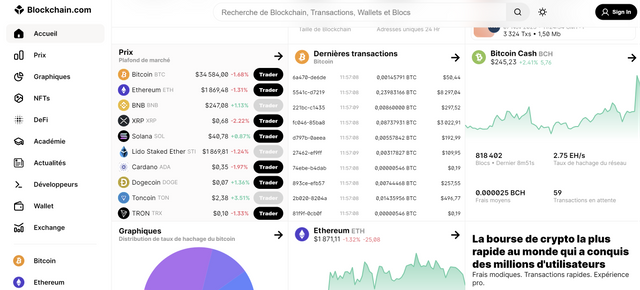Hello Steemians! 👋
In our ongoing "BlockBasics" series, we've journeyed through the fundamentals of blockchain and traced its impressive history from the enigmatic Satoshi Nakamoto to its current status as a global tech phenomenon. Now, it's time to address the elephant in the room – the myths that shroud blockchain in mystery and misconceptions.
It's easy to get lost in a sea of misinformation, especially when you're new to the blockchain universe.
So, let's bust some myths and discover the real magic of blockchain technology.

Summary
- Myth 1: Blockchain and Bitcoin Are the Same
- Myth 2: Blockchain Is Completely Anonymous
- Myth 3: Blockchains Are Unhackable
- Myth 4: Blockchain Is Free and Highly Efficient
- Myth 5: All Blockchains Are Public
- Myth 6: Smart Contracts Execute Themselves Automatically Under Any Circumstance
- Myth 7: Blockchain Is Only Useful for Financial Applications
- Conclusion
Myth 1: Blockchain and Bitcoin Are the Same
One of the most persistent myths is that blockchain and Bitcoin are one and the same. Let's clear this up: Blockchain is the underlying technology; Bitcoin is just the first application of it.
Think of blockchain as the operating system, like Windows or MacOS, and Bitcoin as an application that runs on that system, like Microsoft Office or Photoshop.
Blockchain is a distributed ledger technology that allows data to be stored globally on thousands of servers while letting anyone on the network see everyone else's entries in real-time. It's this system that Bitcoin uses to record transactions.
However, blockchain's potential extends far beyond cryptocurrencies. It can be utilized for anything that requires indisputable record-keeping, like supply chain management, voting systems, healthcare records, and much more.
Myth 2: Blockchain Is Completely Anonymous
Another common belief is that blockchain offers complete anonymity, but in reality, it offers something called pseudonymity. Transactions are not linked to identities but to addresses or pseudonyms.
This distinction is crucial because if someone can link your identity to your blockchain address, they can track your transactions.
While it's true that your name, address, and other personal information are not directly displayed on the blockchain, all transactions are recorded and visible. This means that every transaction made on a public blockchain is traceable. With the right tools and knowledge, interested parties can potentially trace these transactions back to the individuals behind them.
To get a sense of this transparency in action, one can use resources like the Blockchain.com Explorer, one of the oldest and most popular blockchain explorers. This platform allows users to conduct detailed searches of transactions, blocks, and addresses.

It's a clear example of how blockchain data can be publicly audited and reviewed, adding a layer of accountability but also challenging the notion of total anonymity.
Most blockchains are designed to be open ledgers, where transaction details are out in the open. While your real-world identity is not directly attached to your blockchain transactions, sophisticated analysis, sometimes referred to as blockchain forensics, can sometimes de-anonymize users.
Although there are privacy-focused cryptocurrencies like Monero and Zcash that aim to provide true anonymity, the most widely used blockchains, such as Bitcoin and Ethereum, do not provide complete anonymity by default.
Myth 3: Blockchains Are Unhackable
There's a strong belief that blockchains are completely secure and immune to any form of hacking, but this isn't entirely accurate. While blockchains are more secure than many other digital systems due to their decentralized nature and cryptographic underpinnings, they are not infallible.
Vulnerabilities can still exist, primarily in the form of code exploits, human error, or security flaws in peripheral systems.
There have been instances where blockchains, or more accurately, services that use blockchain, have been compromised. Notable examples include the DAO attack on the Ethereum network, where millions of dollars in Ether were siphoned due to smart contract vulnerabilities, and the Mt. Gox exchange hack, where Bitcoin worth several hundred million dollars was stolen.
However, it's important to note that these breaches were not due to a failure of the blockchain itself but were the result of flaws in the smart contract's code or in the security practices of third-party services.
In response to these incidents, rigorous security protocols have been put in place, and smart contract auditing has become a standard practice to prevent similar attacks.
Myth 4: Blockchain Is Free and Highly Efficient
The notion that blockchain is a cost-free and highly efficient technology is a common misconception. Operating a blockchain network involves significant transaction costs and energy consumption.
These costs arise from the need to validate transactions and maintain a consensus across all nodes in the network.
In terms of energy consumption, networks like Bitcoin are often criticized for their intensive energy use due to the Proof of Work (PoW) consensus mechanism, which requires substantial computing power. However, many blockchain networks are exploring or have adopted alternative consensus mechanisms like Proof of Stake (PoS), which are much more energy-efficient.
While blockchain can offer efficiency improvements over traditional systems, especially in areas like cross-border payments or complex supply chains, it's important to weigh these benefits against the costs and environmental impact.
Myth 5: All Blockchains Are Public
Not all blockchains are created equal, and a one-size-fits-all description doesn't cover the diverse types of blockchains that exist.
There are public blockchains, like Bitcoin and Ethereum, which anyone can join and participate in.
Then there are private blockchains, where participation is restricted and controlled by a single organization or a consortium of entities.
Lastly, there are consortium blockchains, which operate under the leadership of a group rather than a single entity, balancing between the open nature of public blockchains and the controlled access of private ones.
Each type of blockchain has its own set of use-cases.
Public blockchains are ideal for scenarios where trustless, transparent interactions are needed, such as in cryptocurrencies.
Private blockchains are suitable for business processes among limited entities where privacy and control are priorities.
Consortium blockchains are often used in business collaborations, where multiple organizations need to share responsibility for the network.
Understanding these distinctions is critical to recognizing the appropriate applications and limitations of different blockchain architectures.
Myth 6: Smart Contracts Execute Themselves Automatically Under Any Circumstance
Smart contracts are often thought to be self-acting under any condition, but they are not quite the all-powerful automatons they're sometimes made out to be.
In reality, smart contracts require specific conditions to be met before they execute, and these conditions must be defined clearly and unambiguously in the contract code.
If the necessary conditions aren't met, a smart contract will not execute, just like any other computer program.
Furthermore, smart contracts are limited by the information available on the blockchain. When they need to interact with the real world or external data, they require Oracles—services that feed external data to the blockchain that smart contracts can use. However, the reliance on Oracles introduces a degree of risk, as they become potential points of failure or manipulation.
Myth 7: Blockchain Is Only Useful for Financial Applications
While blockchain technology debuted in the financial industry with Bitcoin, its potential stretches far beyond. Today, blockchain is making waves in numerous sectors, transforming the way we think about data sharing, transparency, and trust.
Non-financial use cases of blockchain include supply chain management, where it can bring unparalleled traceability and verification of goods from production to delivery. In healthcare, blockchain can secure the sharing of medical records, ensuring privacy and patient control over their information. In the arts, it's enabling new forms of digital ownership and authenticity verification, such as with Non-Fungible Tokens (NFTs). In voting systems, blockchain can provide secure and tamper-proof methods for recording votes.
Conclusion
Demystifying the myths surrounding blockchain is essential for its continued adoption and proper application. It's important that as we explore the capabilities of blockchain technology, we maintain a critical but open-minded perspective.
Only by addressing misconceptions can we harness the true potential of blockchain and innovate responsibly.
Whether you're a developer, an entrepreneur, or just a curious individual, keep questioning and learning about blockchain. Your informed approach will not only benefit your understanding but will also contribute to the healthy evolution of this groundbreaking technology.
Previous articles:
- BlockBasics 0.0.0 : Embarking on a Blockchain Adventure - A Developer's Fresh Perspective
- BlockBasics 1.1.1: What is Blockchain? - A Beginner's Guide
- BlockBasics 1.1.2: The History of Blockchain: From Satoshi to Global Adoption
😊 Join the Conversation:
What's your take on the blockchain revolution? 🚀 Have you encountered any applications of blockchain in your life or work that surprised you? Share your stories in the comments below! 👇
❤️ Support the Journey:
Every upvote 👍, comment 💬, and resteem 🔁 not only fuels my passion for writing but also supports the creation of more educational content. Let's demystify the tech together!